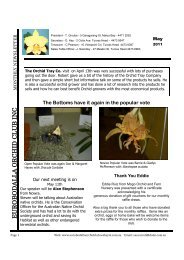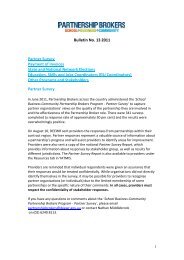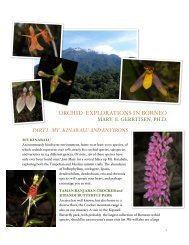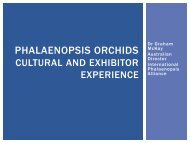Orchid Growing Substrates
Orchid Growing Substrates
Orchid Growing Substrates
Create successful ePaper yourself
Turn your PDF publications into a flip-book with our unique Google optimized e-Paper software.
watering/fertilizer solution, applied only to damp, but never water the mix. It was an art, but working<br />
well.<br />
- The hidden peat. Many companies blending mixes of various ingredients, for commercial purposes,<br />
with lime and slow release fertilizer (usually PG Mix) use a very low amount of peat to dilute the initial<br />
ingredients, and help for their dispersion during the blending process. It is usually very fine graded<br />
peat of not really good quality, and it can pose problems, when the roots of the plants encounter it, if<br />
they are sensitive to low pH it can stop them. For a Phalaenopsis or a kitchen table dendrobium, it can<br />
be fine, and the root will die, that’s it. For some sensitive Paphiopedilum, that make only few roots<br />
per year, losing a root tip this way, and the usual root rot that follows can be a disaster. In the<br />
Netherlands one grower lost benches and benches of Paphiopedilum just because of the low quantity<br />
of peat added, that settled at the bottom of the pot, in a really minute amount, but was at a pH of 3.7.<br />
- Peat can be really acidic, and values down to 3.1 are not unheard of. It is usually blended with<br />
dolomitic limestone by some sellers, though some people sell it straight, and it is up to the grower to<br />
correct the pH. It is always best, if someone wants to buy straight peat, to buy some of the famous<br />
brand ‘buffered’ peats, even with the micronutrients and fertilizer blends included, though we no<br />
longer can recommend the use of peat like it would have been possible over two decades ago.<br />
Nevertheless, it has never been a long term potting mix or even potting ingredient.<br />
Coconut and coco products.<br />
- Xavier has been one of the first users of shredded coconut in Europe for <strong>Orchid</strong>s and especially<br />
Paphiopedilum in 1992. At that time, it was usually limited to some Asian and African countries, which<br />
had ready access to coconut. In those days, the results were absolutely amazing, blended with bark.<br />
However, the product of that time, that helped to establish the fame of the coconut products for<br />
orchids, and many other crops, will never be available again. Here is the story.<br />
- The Sri Lanka <strong>Orchid</strong> Society published a pamphlet in 1952 regarding the use of coconut for planting<br />
orchids. It is the earliest mention in a ‘westerner‘publication of the use of coconut for planting<br />
orchids, though it was done in those days already by some growers in Asia. It is funny to note too that<br />
Sri Lanka would become, nearly half a century later, the ‘base’ for coconut products production<br />
around the world.<br />
- In the 80’s, some people oversaw huge stockpiles of rotting and rotted coconut shells, sometimes<br />
decades old stocks. They had the idea to process it to make potting mix. The fines went to make a<br />
kind of peat, and the intact parts were crushed, to make a kind of thing that was akin to the long fiber<br />
peat moss, brownish black, fluffy, retaining a lot of water, like a sponge. It would look like torn apart,<br />
pieces of a brand new brown coconut shell, but of a black color, and completely water absorbent. The<br />
coconut had been weathered for ages, and it had no longer any salts, except the powder, that was<br />
harvested at the bottom of the stockpile, and could contain both sea salt and sand as a bonus, not to<br />
mention fusarium spores and a wide range of weird things along with insects. However, those<br />
shredder pieces of black weathered coconut, mixed with big size European bark, that was still of<br />
Xavier Garreau de Loubresse<br />
18
















